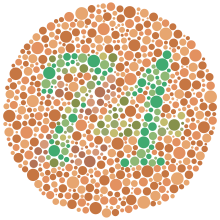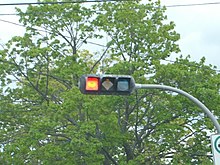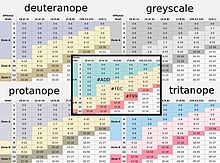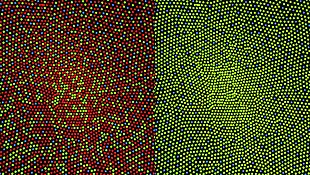
A | B | C | D | E | F | G | H | CH | I | J | K | L | M | N | O | P | Q | R | S | T | U | V | W | X | Y | Z | 0 | 1 | 2 | 3 | 4 | 5 | 6 | 7 | 8 | 9
| Color blindness | |
|---|---|
| Other names | Color vision deficiency, impaired color vision[1] |
 | |
| Example of an Ishihara color test plate. Viewers with normal color vision should clearly see the number "74". | |
| Specialty | Ophthalmology |
| Symptoms | Decreased ability to see colors[2] |
| Duration | Long term[2] |
| Causes | Genetic (inherited usually X-linked)[2] |
| Diagnostic method | Ishihara color test[2] |
| Treatment | Adjustments to teaching methods, mobile apps[1][2] |
| Frequency | Red–green: 8% males, 0.5% females (Northern European descent)[2] |
Color blindness or color vision deficiency (CVD) is the decreased ability to see color or differences in color.[2] The severity of color blindness ranges from mostly unnoticeable to full absence of color perception. Color blindness is usually an inherited problem or variation in the functionality of one or more of the three classes of cone cells in the retina, which mediate color vision.[2] The most common form is caused by a genetic condition called congenital red–green color blindness (including protan and deutan types), which affects up to 1 in 12 males (8%) and 1 in 200 females (0.5%).[2][3] The condition is more prevalent in males, because the opsin genes responsible are located on the X chromosome.[2] Rarer genetic conditions causing color blindness include congenital blue–yellow color blindness (tritan type), blue cone monochromacy, and achromatopsia. Color blindness can also result from physical or chemical damage to the eye, the optic nerve, parts of the brain, or from medication toxicity.[2] Color vision also naturally degrades in old age.[2]
Diagnosis of color blindness is usually done with a color vision test, such as the Ishihara test. There is no cure for most causes of color blindness, however there is ongoing research into gene therapy for some severe conditions causing color blindness.[2] Minor forms of color blindness do not significantly affect daily life and the color blind automatically develop adaptations and coping mechanisms to compensate for the deficiency.[2] However, diagnosis may allow an individual, or their parents/teachers, to actively accommodate the condition.[1] Color blind glasses (e.g. EnChroma) may help the red–green color blind at some color tasks,[2] but they do not grant the wearer "normal color vision" or the ability to see "new" colors.[4] Some mobile apps can use a device's camera to identify colors.[2]
Depending on the jurisdiction, the color blind are ineligible for certain careers,[1] such as aircraft pilots, train drivers, police officers, firefighters, and members of the armed forces.[1][5] The effect of color blindness on artistic ability is controversial,[1][6] but a number of famous artists are believed to have been color blind.[1][7]
Effects
A color blind person will have decreased (or no) color discrimination along the red–green axis, blue–yellow axis, or both. However, the vast majority of the color blind are only affected on their red–green axis.
The first indication of color blindness generally consists of a person using the wrong color for an object, such as when painting, or calling a color by the wrong name. The colors that are confused are very consistent among people with the same type of color blindness.
-
Normal sight
-
Deuteranopic sight
-
Protanopic sight
-
Tritanopic sight
-
Monochromatic sight
Confusion colors

Confusion colors are pairs or groups of colors that will often be mistaken by the color blind. Confusion colors for red–green color blindness include:
- cyan and grey
- rose-pink and grey
- blue and purple
- yellow and neon green
- red, green, orange, brown
Confusion colors for tritan include:
- yellow and grey
- blue and green
- dark blue/violet and black
- violet and yellow-green
- red and rose-pink
These colors of confusion are defined quantitatively by straight confusion lines plotted in CIEXYZ, usually plotted on the corresponding chromaticity diagram. The lines all intersect at a copunctal point, which varies with the type of color blindness.[8] Chromaticities along a confusion line will appear metameric to dichromats of that type. Anomalous trichromats of that type will see the chromaticities as metameric if they are close enough, depending on the strength of their CVD. For two colors on a confusion line to be metameric, the chromaticities first have to be made isoluminant, meaning equal in lightness. Also, colors that may be isoluminant to the standard observer may not be isoluminant to a person with dichromacy.
Color tasks
Cole describes four color tasks, all of which are impeded to some degree by color blindness:[9]
- Comparative – When multiple colors must be compared, such as with mixing paint
- Connotative – When colors are given an implicit meaning, such as red = stop
- Denotative – When identifying colors, for example by name, such as "where is the yellow ball?"
- Aesthetic – When colors look nice – or convey an emotional response – but do not carry explicit meaning
The following sections describe specific color tasks with which the color blind typically have difficulty.
Food

Color blindness causes difficulty with the connotative color tasks associated with selecting or preparing food. Selecting food for ripeness can be difficult; the green–yellow transition of bananas is particularly hard to identify. It can also be difficult to detect bruises, mold, or rot on some foods, to determine when meat is done by color, to distinguish some varietals, such as a Braeburn vs. a Granny Smith apple, or to distinguish colors associated with artificial flavors (e.g. jelly beans, sports drinks).
Skin color
Changes in skin color due to bruising, sunburn, rashes or even blushing are easily missed by the red–green color blind.
Traffic lights

The colors of traffic lights can be difficult for the red–green color blindness. This difficulty includes distinguishing red/amber lights from sodium street lamps, distinguishing green lights (closer to cyan) from normal white lights, and distinguishing red from amber lights, especially when there are no positional clues available (see image).

The main coping mechanism to overcome these challenges is to memorize the position of lights. The order of the common triplet traffic light is standardized as red–amber–green from top to bottom or left to right. Cases that deviate from this standard are rare. One such case is a traffic light in Tipperary Hill in Syracuse, New York, which is upside-down (green–amber–red top to bottom) due to the sentiments of its Irish American community.[10] However, the light has been criticized due to the potential hazard it poses for color blind drivers.[11]

There are other several features of traffic lights available that help accommodate the color blind. British Rail signals use more easily identifiable colors: The red is blood red, the amber is yellow and the green is a bluish color.[citation needed] Most British road traffic lights are mounted vertically on a black rectangle with a white border (forming a "sighting board"), so that drivers can more easily look for the position of the light. In the eastern provinces of Canada, traffic lights are sometimes differentiated by shape in addition to color: square for red, diamond for yellow, and circle for green (see image).
Signal lights
Navigation lights in marine and aviation settings employ red and green lights to signal the relative position of other ships or aircraft. Railway signal lights also rely heavily on red–green–yellow colors. In both cases, these color combinations can be difficult for the red–green color blind. Lantern Tests are a common means of simulating these light sources to determine not necessarily whether someone is color blind, but whether they can functionally distinguish these specific signal colors. Those who cannot pass this test are generally completely restricted from working on aircraft, ships or rail, for example.
Fashion
Color analysis is the analysis of color in its use in fashion, to determine personal color combinations that are most aesthetically pleasing.[12] Colors to combine can include clothing, accessories, makeup, hair color, skin color, eye color, etc. Color analysis involves many aesthetic and comparative color task that can be difficult for the color blind.
Art
Inability to distinguish color does not necessarily preclude the ability to become a celebrated artist. The 20th century expressionist painter Clifton Pugh, three-time winner of Australia's Archibald Prize, on biographical, gene inheritance and other grounds has been identified as a person with protanopia.[13] 19th century French artist Charles Méryon became successful by concentrating on etching rather than painting after he was diagnosed as having a red–green deficiency.[14] Jin Kim's red–green color blindness did not stop him from becoming first an animator and later a character designer with Walt Disney Animation Studios.[15]
Advantages
Deuteranomals are better at distinguishing shades of khaki,[16] which may be advantageous when looking for predators, food, or camouflaged objects hidden among foliage.[17] Dichromats tend to learn to use texture and shape clues and so may be able to penetrate camouflage that has been designed to deceive individuals with normal color vision.[18][19]
Some tentative evidence finds that the color blind are better at penetrating certain color camouflages. Such findings may give an evolutionary reason for the high rate of red–green color blindness.[18] There is also a study suggesting that people with some types of color blindness can distinguish colors that people with normal color vision are not able to distinguish.[20] In World War II, color blind observers were used to penetrate camouflage.[21]
In the presence of chromatic noise, the color blind are more capable of seeing a luminous signal, as long as the chromatic noise appears metameric to them.[22] This is the effect behind most "reverse" Pseudoisochromatic plates (e.g. "hidden digit" Ishihara plates) that are discernible to the color blind but unreadable to people with typical color vision.[citation needed]
Digital design

Color codes are useful tools for designers to convey information. The interpretation of this information requires users to perform a variety of Color Tasks, usually comparative but also sometimes connotative or denotative. However, these tasks are often problematic for the color blind when design of the color code has not followed best practices for accessibility.[23] For example, one of the most ubiquitous connotative color codes is the "red means bad and green means good" or similar systems, based on the classic signal light colors. However, this color coding will almost always be undifferentiable to deutans or protans, and therefore should be avoided or supplemented with a parallel connotative system (symbols, smileys, etc.).
Good practices to ensure design is accessible to the color blind include:
- When possible (e.g. in simple video games or apps), allowing the user to choose their own colors is the most inclusive design practice.
- Using other signals that are parallel to the color coding, such as patterns, shapes, size or order.[24] This not only helps the color blind, but also aids understanding by normally sighted people by providing them with multiple reinforcing cues.
- Using brightness contrast (different shades) in addition to color contrast (different hues)
- To achieve good contrast, conventional wisdom suggests converting a (digital) design to grayscale to ensure there is sufficient brightness contrast between colors. However, this does not account for the different perceptions of brightness to different varieties of color blindness, especially protan CVD, tritan CVD and monochromacy.
- Viewing the design through a CVD Simulator to ensure the information carried by color is still sufficiently conveyed. At a minimum, the design should be tested for deutan CVD, the most common kind of color blindness.
- Maximizing the area of colors (e.g. increase size, thickness or boldness of colored element) makes the color easier to identify. Color contrast improves as the angle the color subtends on the retina increases. This applies to all types of color vision.
- Maximizing brightness (value) and saturation (chroma) of the colors to maximize color contrast.
- Converting connotative tasks to comparative tasks by including a legend, even when the meaning is considered obvious (e.g. red means danger).
- Avoiding denotative color tasks (color naming) when possible. Some denotative tasks can be converted to comparative tasks by depicting the actual color whenever the color name is mentioned; for example, colored typography in "purple", purple or "purple ( )".
- For denotative tasks (color naming), using the most common shades of colors. For example, green and yellow are colors of confusion in red–green CVD, but it is not common to mix forest green ( ) with bright yellow ( ). Mistakes by the color blind increase drastically when uncommon shades are used, e.g. neon green ( ) with dark yellow ( ).
- For denotative tasks, using colors that are classically associated with a color name. For example, use "firetruck" red ( ) instead of burgundy ( ) to represent the word "red".
Unordered Information

A common task for designers is to select a subset of colors (qualitative colormap) that are as mutually differentiable as possible (salient). For example, player pieces in a board game should be as different as possible.
Classic advice suggests using Brewer palettes, but several of these are not actually accessible to the color blind.
Unfortunately, the colors with the greatest contrast to the red–green color blind tend to be colors of confusion to the blue–yellow color blind, and vice versa. However, since red–green is much more prevalent than blue–yellow CVD, design should[according to whom?] generally prioritize those users (deutans then protans).
Ordered Information

A common task for data visualization is to represent a color scale, or sequential colormap, often in the form of a heat map or choropleth. Several scales are designed with special consideration for the color blind and are widespread in academia, including Cividis,[25] Viridis[25] and Parula. These comprise a light-to-dark scale superimposed on a yellow-to-blue scale, making them monotonic and perceptually uniform to all forms of color vision.
Classification

Much terminology has existed and does exist for the classification of color blindness, but the typical classification for color blindness follows the von Kries classifications,[26] which uses severity and affected cone for naming.
Based on severity
Based on clinical appearance, color blindness may be described as total or partial. Total color blindness (monochromacy) is much less common than partial color blindness.[27] Partial color blindness includes dichromacy and anomalous trichromacy, but is often clinically defined as mild, moderate or strong.
Monochromacy
Monochromacy is often called total color blindness since there is no ability to see color. Although the term may refer to acquired disorders such as cerebral achromatopsia, it typically refers to congenital color vision disorders, namely rod monochromacy and blue cone monochromacy).[28][29]
In cerebral achromatopsia, a person cannot perceive colors even though the eyes are capable of distinguishing them. Some sources do not consider these to be true color blindness, because the failure is of perception, not of vision. They are forms of visual agnosia.[29]
Monochromacy is the condition of possessing only a single channel for conveying information about color. Monochromats are unable to distinguish any colors and perceive only variations in brightness. Congenital monochromacy occurs in two primary forms:
- Rod monochromacy, frequently called complete achromatopsia, where the retina contains no cone cells, so that in addition to the absence of color discrimination, vision in lights of normal intensity is difficult.
- Cone monochromacy is the condition of having only a single class of cone. A cone monochromat can have good pattern vision at normal daylight levels, but will not be able to distinguish hues. Cone monochromacy is divided into classes defined by the single remaining cone class. However, red and green cone monochromats have not been definitively described in the literature. Blue cone monochromacy is caused by lack of functionality of L (red) and M (green) cones, and is therefore mediated by the same genes as red–green color blindness (on the X chromosome). Peak spectral sensitivities are in the blue region of the visible spectrum (near 440 nm). People with this condition generally show nystagmus ("jiggling eyes"), photophobia (light sensitivity), reduced visual acuity, and myopia (nearsightedness).[30] Visual acuity usually falls to the 20/50 to 20/400 range.
Dichromacy
Dichromats can match any color they see with some mixture of just two primary colors (in contrast to those with normal sight (trichromats) who can distinguish three primary colors).[28] Dichromats usually know they have a color vision problem, and it can affect their daily lives. Dichromacy in humans includes protanopia, deuteranopia, and tritanopia. Out of the male population, 2% have severe difficulties distinguishing between red, orange, yellow, and green (orange and yellow are different combinations of red and green light). Colors in this range, which appear very different to a normal viewer, appear to a dichromat to be the same or a similar color. The terms protanopia, deuteranopia, and tritanopia come from Greek, and respectively mean "inability to see (anopia) with the first (prot-), second (deuter-), or third (trit-) ".
Anomalous trichromacy
Anomalous trichromacy is the mildest type of color deficiency, but the severity ranges from almost dichromacy (strong) to almost normal trichromacy (mild).[31] In fact, many mild anomalous trichromats have very little difficulty carrying out tasks that require normal color vision and some may not even be aware that they have a color vision deficiency. The types of anomalous trichromacy include protanomaly, deuteranomaly and tritanomaly. It is approximately three times more common than dichromacy.[32] Anomalous trichromats exhibit trichromacy, but the color matches they make differ from normal trichromats. In order to match a given spectral yellow light, protanomalous observers need more red light in a red/green mixture than a normal observer, and deuteranomalous observers need more green. This difference can be measured by an instrument called an Anomaloscope, where red and green lights are mixed by a subject to match a yellow light.[33]
Based on affected cone
There are two major types of color blindness: difficulty distinguishing between red and green, and difficulty distinguishing between blue and yellow.[34][35][dubious – discuss] These definitions are based on the phenotype of the partial color blindness. Clinically, it is more common to use a genotypical definition, which describes which cone/opsin is affected.
Red–green color blindness
Red–green color blindness includes protan and deutan CVD. Protan CVD is related to the L-cone and includes protanomaly (anomalous trichromacy) and protanopia (dichromacy). Deutan CVD is related to the M-cone and includes deuteranomaly (anomalous trichromacy) and deuteranopia (dichromacy).[36][37] The phenotype (visual experience) of deutans and protans is quite similar. Common colors of confusion include red/brown/green/yellow as well as blue/purple. Both forms are almost always symptomatic of congenital red–green color blindness, so affects males disproportionately more than females.[38] This form of color blindness is sometimes referred to as daltonism after John Dalton, who had red–green dichromacy. In some languages, daltonism is still used to describe red–green color blindness.

- Protan (2% of males): Lacking, or possessing anomalous L-opsins for long-wavelength sensitive cone cells. Protans have a neutral point at a cyan-like wavelength around 492 nm (see spectral color for comparison)—that is, they cannot discriminate light of this wavelength from white. For a protanope, the brightness of red is much reduced compared to normal.[39] This dimming can be so pronounced that reds may be confused with black or dark gray, and red traffic lights may appear to be extinguished. They may learn to distinguish reds from yellows primarily on the basis of their apparent brightness or lightness, not on any perceptible hue difference. Violet, lavender, and purple are indistinguishable from various shades of blue. A very few people have been found who have one normal eye and one protanopic eye. These unilateral dichromats report that with only their protanopic eye open, they see wavelengths shorter than neutral point as blue and those longer than it as yellow.
- Deutan (6% of males): Lacking, or possessing anomalous M-opsins for medium-wavelength sensitive cone cells. Their neutral point is at a slightly longer wavelength, 498 nm, a more greenish hue of cyan. Deutans have the same hue discrimination problems as protans, but without the dimming of long wavelengths. Deuteranopic unilateral dichromats report that with only their deuteranopic eye open, they see wavelengths shorter than neutral point as blue and longer than it as yellow.[40]
Blue–yellow color blindness
Blue–yellow color blindness includes tritan CVD. Tritan CVD is related to the S-cone and includes tritanomaly (anomalous trichromacy) and tritanopia (dichromacy). Blue–yellow color blindness is much less common than red–green color blindness, and more often has acquired causes than genetic. Tritans have difficulty discerning between bluish and greenish hues.[41] Tritans have a neutral point at 571 nm (yellowish).[citation needed]
- Tritan (< 0.01% of individuals): Lacking, or possessing anomalous S-opsins or short-wavelength sensitive cone cells. Tritans see short-wavelength colors (blue, indigo and spectral violet) as greenish and drastically dimmed, some of these colors even as black. Yellow and orange are indistinguishable from white and pink respectively, and purple colors are perceived as various shades of red. Unlike protans and deutans, the mutation for this color blindness is carried on chromosome 7. Therefore, it is not sex-linked (equally prevalent in both males and females). The OMIM gene code for this mutation is 304000 "Colorblindness, Partial Tritanomaly".[42]
- Tetartan is the "fourth type" of color blindness, and a type of blue–yellow color blindness. However, its existence is hypothetical and given the molecular basis of human color vision, it is unlikely this type could exist. [43]
Summary of cone complements
The below table shows the cone complements for different types of human color vision, including those considered color blindness, normal color vision and 'superior' color vision. The cone complement contains the types of cones (or their opsins) expressed by an individual.
| Cone system | Red | Green | Blue | N = normal A = anomalous | ||||||||
| N | A | N | A | N | A | |||||||
| 1 | Normal vision | Trichromacy | Normal | |||||||||
| 2 | Protanomaly | Anomalous trichromacy | Partial color blindness |
Red– green | ||||||||
| 3 | Protanopia | Dichromacy | ||||||||||
| 4 | Deuteranomaly | Anomalous trichromacy | ||||||||||
| 5 | Deuteranopia | Dichromacy | ||||||||||
| 6 | Tritanomaly | Zdroj:https://en.wikipedia.org?pojem=Color_vision_deficiency | ||||||||||





